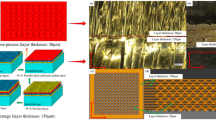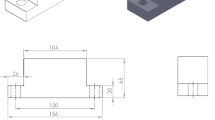Abstract
Rail transportation systems constantly developing as a result of the increase in demand both in high-speed and freight operations globally. According to this demand and the increase in operational frequency the components fail rapidly. To extend the service life it is desired to develop high strength materials for the critical components of the rail systems. Therefore, in this study, isothermal transformation applied to extracted high carbon rail steels in order to obtain bainitic microstructure under various boundary conditions which shows superior mechanical properties. The experimental studies were conducted under varying austenitizing temperature, transformation time and temperature. The change in microstructure results with improved mechanical properties where combined high tensile strength and toughness values were obtained. Optical and SEM micrograph, XRD analysis and mechanical tests (hardness, impact, tensile tests) were carried out to clarify characteristics of the developed materials. The optimum combination of boundary conditions was obtained by using the analysis of signal to noise (S/N) ratio. In conclusion developed rail steels show better mechanical properties than conventional ones by 21 % in hardness, 16 % in tensile strength, 40 % in elongation and optimum parameters for heat treatment processes are clarified with Taguchi-based grey relational analysis.
Similar content being viewed by others
References
Z. Popović, L. Lazarević, L. Brajovic and P. Gladov, Managing rail service life, Metalurgija, 53 (2014) 721–724.
N. O. Atto-Okine, Big Data and Differential Privacy Wiley Series in Operations Research and Management Science, John Wiley & Sons, Inc., NJ, USA (2017).
D. Gattuso and A. Restuccia, A tool for railway transport cost evaluation, Procedia - Soc. Behav. Sci., 111 (2014) 549–558.
Y. Sarıkavak, Tekerlek ray etkileşimi, perlitik ve beynitik Çeliklerin yorulma hasar direnci Üzerine bir sonlu elemanlar analizi, Demiryolu Mühendisliği, 14 (2021) 65–76, doi:https://doi.org/10.47072/demiryolu.934471.
F. P. L. Kavishe and T. J. Baker, Effect of prior austenite grain size and pearlite interlamellar spacing on strength and fracture toughness of a eutectoid rail steel, Mater. Sci. Technol. (United Kingdom), 2 (8) (1986) 816–822.
K. Anioek and J. Herian, The structure, properties and a resistance to abrasive wear of railway sections of steel with a different pearlite morphology, IOP Conf. Ser.: Mater. Sci. Eng., 22 (2011).
H. Muster, H. Schmedders, K. Wick and H. Pradier, Rail rolling contact fatigue. The performance of naturally hard and head-hardened rails in track, Wear, 191 (1–2) (1996) 54–64.
A. C. Athukorala, D. V. De Pellegrin and K. I. Kourousis, A unified material model to predict ratcheting response in head-hardened rail steel due to non-uniform hardness distributions, Tribol. Int., 111 (February) (2017) 26–38.
C. E. Pitt, Wear and microstructure relationships in carbide-free bainitic rail steel, Ph.D. Thesis, Univ. of Cambridge (1999).
A. Ray, Niobium in microalloyed rail steels, Proceedings of HSLA Steels 2015, Microalloying 2015 & Offshore Engineering Steels 2015 (2016) 33–39.
K. M. Lee and A. A. Polycarpou, Wear of conventional pearlitic and improved bainitic rail steels, Wear, 259 (1–6) (2005) 391–399.
P. Folgarait and A. Saccocco, Bainitic Steels for New Rail Materials (Technical Steel Research), Publications Office of the EU: Luxemburg (2006).
Y. Sarikavak, An advanced modelling to improve the prediction of thermal distribution in friction stir welding (FSW) for difficult to weld materials, J. Brazilian Soc. Mech. Sci. Eng., 43 (1) (2021).
H. K. D. H. Bhadeshia, Novel steels for rails, Engyclopedia of Materials: Science and Technology, Second Ed., Elsevier (2002) 1–7.
I. Hlavatý, M. Sigmund, L. Krejčí and P. Mohyla, The bainitic steels for rails applications, Mater. Eng., 16 (4) (2009) 44–50.
C. H. Suh, R. G. Lee, S. K. Oh, Y.-C. Jung, J.-Y. Son and Y. S. Kim, Effect of welding heat input on fatigue life of quenched boron steel and FB steel lap joint, J. Mech. Sci. Technol., 25 (7) (2011) 1727–1735.
S. Ragu Nathan, V. Balasubramanian, S. Malarvizhi and A. G. Rao, Effect of welding processes on mechanical and microstructural characteristics of high strength low alloy naval grade steel joints, Def. Technol., 11 (3) (2015) 308–317.
G. F. Vander Voort, Atlas of Time Temperature Diagrams for Irons and Steels, ASM International (1991).
Y. Hiroyasu, S. Mitao, S. Yamamoto, Y. Kataoka and T. Sugiyama, High strength bainitic steel rails for heavy haul railways with superior damage resistance, NKK Tech. Rev. (84) (2001) 44–51.
M. Zhu, G. Xu, M. Zhou, Q. Yuan, J. Tian and H. Hu, Effects of tempering on the microstructure and properties of a high-strength bainite rail steel with good toughness, Metals (Basel), 8 (7) (2018).
K. Fang, J. G. Yang, X. S. Liu, K. J. Song, H. Y. Fang and H. K. D. H. Bhadeshia, Regeneration technique for welding nanostructured bainite, Mater. Des., 50 (2013) 38–43.
K. K. Wang, Z. L. Tan, G. H. Gao, X. L. Gui and B. Z. Bai, Effect of retained austenite stability on mechanical properties of bainitic rail steel, Adv. Mater. Res., 1004–1005 (2014) 198–202.
J. J. Kalker, D. F. Cannon and O. Orringer, Rail Quality and Maintenance for Modern Railway Operation, Springer-Science+Business Media, B.V. (2018).
H. A. Aglan, Z. Y. Liu, M. F. Hassan and M. Fateh, Mechanical and fracture behavior of bainitic rail steel, J. Mater. Process. Technol., 151 (1–3 SPEC. ISS.) (2004) 268–274.
F. H. Çakir and O. N. Çelik, Effect of isothermal bainitic quenching on rail steel impact strength and wear resistance, Met. Sci. Heat Treat., 59 (5–6) (2017) 289–293.
L. Lan and X. Kong, Transformation stasis phenomenon of bainite formation in low-carbon, multicomponent alloyed steel, JOM, 70 (5) (2018) 666–671.
H. S. Yang and H. K. D. H. Bhadeshia, Designing low carbon, low temperature bainite, Mater. Sci. Technol., 24 (3) (2008) 335–342.
N. J. P. Clayton and R. Devanathan, A review of bainitic steels for wheel/rail contact, J. J. Kalker (Ed.), Rail Quality and Maintenance for Modern Railway Operation, Kluwer Academic Publishers (1993) 41–51.
R. Devanathan and P. Clayton, Rolling-sliding wear behavior of three bainitic steels, Wear, 151 (2) (1991) 255–267.
J. Pacyna, The microstructure and properties of the new bainitic rail steels, J. Achiev. Mater. Manuf. Eng., 28 (1) (2008) 19–22.
D. Kong, Q. Liu and L. Yuan, Effect of austenitizing temperature on formation of hard bainite, Met. Sci. Heat Treat., 56 (7–8) (2014) 444–448.
J. K. Yates, Innovation in rail steel, Sci. Parliam, 53 (1996) 2–3.
H. K. D. H. Bhadesh, High performance bainitic steels, Mater. Sci. Forum, 501 (2005) 63–74.
X. Wang, H. Zhao, C. Shang and X. He, The microstructure and properties of high performance steels with low yield-to-tensile ratio, J. Alloys Compd., 577 (SUPPL. 1) (2013) S678–S683.
J. Cornide, C. Garcia-Mateo, C. Capdevila and F.G. Caballero, An assessment of the contributing factors to the nanoscale structural refinement of advanced bainitic steels, J. Alloys Compd., 577 (SUPPL. 1) (2013) S43–S47.
C. García-Mateo and F.G. Caballero, The role of retained austenite on tensile properties of steels with bainitic microstructures, Mater. Trans., 46 (8) (2005) 1839–1846.
K. T. Park and H. J. Kwon, Interpretation of the strengthening of steel with lower bainite and martensite mixed microstructure, Met. Mater. Int., 7 (2) (2001) 95–99.
Ö. F. Murathan and V. Kılıçlı, Nano beynitik çelikler, J. Polytech, 19 (2) (2016) 115–128.
CEN, Railway Applications-Track-Rail-Part 1: Vignole Railway Rails 46 kg/m and Above, EN 13674-1, European Standard, CEN (2003).
CEN, Metallic Materials-Tensile Testing-Part 1: Method of Test at Room Temperature, TS EN ISO 6892-1, Turkish Standard, CEN (2010).
G. Krauss, Steels Processing, Structure, and Performance, ASM International (2015).
ISO, Steel — Charpy V-Notch Pendulum Impact Test — Instrumented Test Method, ISO 14556:2000, ISO (2000).
E. Nas and N. A. Ozbek, Optimization the machining parameters in turning of hardened hot work tool steel using cryogenically treated tools, Surf. Rev. Lett., 27 (4) (2019).
N. Tosun, C. Cogun and G. Tosun, A study on kerf and material removal rate in wire electrical discharge machining based on taguchi method, J. Mater. Process. Technol., 152 (3) (2004) 316–322.
P. A. Gadge, A. C. Waghmare and R. D. Askhedkar, Optimization by grey relational analysis (GRA) to determine the reverse osmosis parameter for distillery effluent in ZLD process, International J. of Engineering Science and Computing, 7 (2) (2017) 4413–4419.
E. Nas and S. Akıncıoğlu, Optimization of cryogenic treated nickel-based superalloy in terms of electro- erosion processing performance, Acad. Platf. J. Eng. Sci., 7-1 (2019) 115–126.
E. Yılmaz and F. Güngör, Gri ilişkisel analiz yöntemine göre farkli sertliklerde optimum takim tutucusunun belirlenmesi, 2 Ulus. Tasarım İmalat ve Anal. Kongresi (2010) 1–9.
G. F. Vander Voort (Ed.), ASM Handbook Volume 9: Metallography and Microstructures, ASM International (2004).
O. Haiko, P. Kaikkonen, M. Somani, K. Valtonen and J. Kömi, Characteristics of carbide-free medium-carbon bainitic steels in high-stress abrasive wear conditions, Wear, 456–457 (2020) 203386.
Acknowledgements
The authors acknowledge the Railway Research and Technology Centre (DATEM) of Turkish State Railways and the support received from the Ankara Yıldırım Beyazıt University Scientific Research Projects Coordination Unit under grant number 2155.
Author information
Authors and Affiliations
Corresponding author
Additional information
Conflict of interests
The authors declare that they have no known actual or potential conflicts of interest with respect to the research, the authorship and/or the publication of this article.
Abdulkadir Kilic is a mechanical engineer and PhD candidate in Ankara Yıldırım Beyazıt University Mechanical Engineering Department. His research interests include railway materials, mechanical properties of materials, optimization, and mechanical tests.
Yasin Sarikavak is currently teaching at Ankara Yıldırım Beyazıt University, Mechanical Engineering Department in Türkiye. His research interests include railway engineering high speed trains, mechanical properties of materials, optimization, numerical simulation of systems, welding and joining, non-destructive inspection, and non-traditional machining.
Rights and permissions
About this article
Cite this article
Kilic, A., Sarikavak, Y. Taguchi based optimization to improve mechanical properties of high carbon rail steels via bainitic microstructure. J Mech Sci Technol 37, 2363–2373 (2023). https://doi.org/10.1007/s12206-023-0413-x
Received:
Revised:
Accepted:
Published:
Issue Date:
DOI: https://doi.org/10.1007/s12206-023-0413-x




